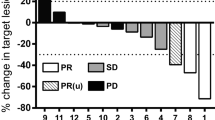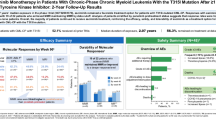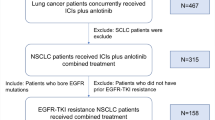Abstract
In vitro and preclinical in vivo data have shown a synergistic antitumor activity between α-interferon and some antiproliferative agents. A phase I study of the concurrent administration of interferon-α 2 and mito-xantrone was initiated, to determine the maximum tolerated dose of mitoxantrone given i.v. every 3 weeks in escalating doses combined with a fixed dose of s.c. interferon α 2 (6 × 106 IU three times per week3), in patients with advanced solid tumors resistant to conventional chemotherapy. At least three evaluable patients were entered in each dose level of mitoxantrone starting at 4 mg/m2, with no escalations allowed in the same patient. Twenty-seven patients received a total of 101 cycles and five dose-levels were explored (4-6-8-10-12 mg/m2 of mitoxantrone). The dose-limiting toxicities were leukopenia and granulocytopenia at 12 mg/m2 of mitoxantrone, at which dose hematological toxicity occurred in > 50% of cases, with one patient presenting grade 4 leuko-granulocytopenia. No severe thrombocytopenia occurred. In the majority of patients transient hepatic enzyme elevations and a flu-like syndrome due to interferon a 2 were observed in all dose-levels explored. These observations suggest that the hepatotoxic effects of interferon a 2 do not emphasize mitoxantrone side-effects if given simultaneously. When mitoxantrone is administered with 6 × 106 IU of interferon α 2, the recommended dose for future phase II studies is 10 mg/m2/weeks3 with escalation up to 12 mg/m2 in selected patients if such a combination is well tolerated in terms of myelosuppression. Regarding therapeutic activity, four out of 25 (16%) cases evaluable for response achieved a partial response. In conclusion the concomitant administration of recombinant interferon α 2 and mitoxantrone allows the possibility to give a therapeutic dosage of both agents. Because the combination of the two agents was fairly well tolerated and antitumor activity was observed, phase II trials are warranted.
Similar content being viewed by others
References
Isaac A, Lindenmann T: Virus interference — I. The Interferon. Proc R Soc Lond B Biol 147:258–267, 1957
Krown SE: Interferons and Interferon inducers in cancer treatment. Sem Oncol 13:207–217, 1986
Pestka S: The purification and manufacture of human interferons. Sci Am 249:37–43, 1983
Oldham RK: Biological response modifiers. J Natl Cancer Inst 70:789–796, 1983
Foon KA: Biological response modifiers: The new immunotherapy. Cancer Res 49:1621–1639, 1989
Gresser I, Tovey MG: Antitumor effects of interferon. Biochem Biophys Acta 516:231–247, 1978
Balkwill FR, Moodie EM, Freedman V, Fantes KH: Human Interferon inhibits the growth of established human breast tumors in nude mide. Int J Cancer 30:231–235, 1982
Roth SM, Foon KA: α-interferon in the treatment of hematologic malignancies. Am J Med 81:871–882, 1986
Merz B: Interferon's track record: Good in hairy-cell leukemia, fair in other hematologic cancers, poor in solid tumors. JAMA 256:1242–1244, 1986
Quesada JR, Rios A, Swanson D, Trown P, Gutterman JU: Antitumor activity of recombinant-derived interferon-α in metastatic renal cell carcinoma. J Clin Oncol 3:1522–1528, 1985
Vugrin D, Hood L, Taylor W, Lazlo J: Phase II study of human lymphoblastoid interferon in patients with advanced renal carcinoma. Cancer Treat Rep 69:817–820, 1985
Legha SS: Interferons in the treatment of malignant melanoma. A review of recent trials. Cancer 57:1675–1677, 1986
Gutterman JU, Blumenschein GR, Alexanian R, et al.: Leukocyte interferon-induced tumor regression in human metastatic breast cancer, multiple myeloma, and malignant lymphoma. Ann Intern Med 93:399–406, 1980
Oberg K, Funa K, Alm G: Effects of leukocyte interferon on clinical symptoms and hormone levels in patients with midgut carcinoid tumors and carcinoid syndrome. N Engl J Med 309:129–133, 1983
Von Hoff DD, Sarosy G, Brown TD, Kuhn JG, Kisner DL: Rationale for and conduct of a phase I clinical trial with interferon alfa-2b plus doxorubicin. Semin Oncol 13:72–77, 1986
Balkwill FR, Moodie EM: Positive interactions between human interferon and cyclophosphamide or adriamycin in a human tumor model system. Cancer Res 44:904–908, 1984
Slater LM, Welzel MW, Cesario MD: Combined interferon-antimetabolite therapy of murine L1210 leukemia. Cancer (Phila.) 48:5–9, 1981
Aapro MS, Alberts DS, Slamon, SE: Interactions of human leukocyte interferon with Vinca alkloids and other chemotherapeutic agents against human tumors in clonogenic assay. Cancer Chemother Pharm 10:161–166, 1983
Carmichael J, Fergusson RJ, Wolf R, Balkwill FR, Smyth JF: Augmentation of cytotoxicity of chemotherapy by human interferons in human non-small cell lung cancer xenografts. Cancer Res 46:4916–4920, 1986
Welander CE, Morgan TM, Homesley HD, Trotta PP, Spiegel RJ: Combined recombinant human interferon alpha 2 and cytotoxic agents studied in a clonogenic assay. Int J Cancer 35:721–729, 1985
Salmon SE, Durie BGM, Young L et al.: Effects of cloned human leukocyte interferons in the human tumor stem cell assay. J Clin Oncol 1:217–225, 1983
Soslau G, Bogucki AR, Gillespie D: Phosphoproteins altered by antiproliferative doses of human interferon β in a human bladder carcinoma cell line. Biochem Biophys Res Commu 119:941–948, 1984
Faltynek CR, Oppenheim JJ: Interferons in host defence, J Natl Cancer Inst 80:151–153, 1988
Balkwill FR, Smyth JR: Interferons in cancer therapy; a reappraisal. Lancet 2:317–319, 1987
Lonberg M, Odajnyk C, Kriegel R, Laubenstein L, Wernz JC, Green MD, Muggia FM: Sequential and simultaneous alpha 2 interferon (INF) and VP16 in epidemic Kaposi's sarcoma (EKS). Proc Am Soc Clin Oncol, C-8, 1985
Sarosy GA, Brown TD, Von Hoff DD, Spiegel RJ, Golando JP, Beougher KL, Kuhn JG, Kisner DL: Phase I study of α2-interferon plus doxorubicin in patients with solid tumors. Cancer Res 46:5368–5371, 1986
Creagan ET, Kovack JS, Long HJ, Richardson RL: Phase I study of recombinant leukocyte A human interferon combined with BCNU in selected patients with advanced cancer. J Clin Oncol 4:408–413, 1986
E.O.R.T.C.: New Drug Development Committee. E.O.R.T.C. guidelines for phase I trials with single agents in adults. Eur J Cancer Clin Oncol 21:1005–1007, 1985
Von Hoff DD, Kuhn J, Clark GM: Design and conduct of phase I trials. In: ME Buyse, M Staquet, RJ Sylvester (eds.), Cancer Clinical Trials. Methods and Practice, pp. 210–220. Oxford: Oxford Univ. Press, 1984
W.H.O. Handbook for Reporting Results of Cancer Treatment. World Health Organization, publ. n∘ 48. Geneva, W.H.O. Offset, 1979
Miller AB, Hoogstraten B, Staquet M, Winkler A: Reporting results of cancer treatment. Cancer 47:207–214, 1981
Von Hoff DD, Polland E, Kuhn J et al.: Phase I clinical investigation of 1,4 dihydroxy-5,8-bis 2-(2-hydroxyethyl-amino)-ethyl-amino -9,10-anthracenedione dihydrochloride (NCS 301739), a new anthracenedione. Cancer Res 40: 1516–1518, 1980
Savaray N, Lu K, Valdivieso M et al.: Pharmacology of mitoxantrone in cancer patients. Cancer Chemother Pharmacol 8:113–117, 1982
Oldham R: Biotherapy: The 4th modality of cancer treatment. J Cell Physiol (Suppl.) 4:91–99, 1986
Fidler JM, De Joy SQ, Gibbons JJ Jr: Selective immunomodulation by the antineoplastic agent mitoxantrone. I. Suppression of B lymphocyte function. J Immunol 137:727–732, 1986
Biologic response modifiers. In: BG Leventhal, RE Wittes (eds.), Research methods in clinical oncology, pp. 171–190. New York: Raven Press, 1988
Green MD, Speyer JL, Hochster HS, Liebes LF, Dunleavy S, Widman T, Wernz JC, Blum RH, Spiegel RJ, Muggia FM: Phase I trial of escalating dose doxorubicin administered concurrently with α-interferon. Cancer Res 48:2574–2578, 1988
Muss HB, Welander C, Caponera M, Reavis K, Cruz JM, Cooper MR, Jackson DV, Richards F, Stuart JJ, Spurr CL, White DR, Zekan PJ, Capizzi RL: Interferon and doxorubicin in renal cell carcinoma. Cancer Treat Rep 69:721–722, 1985
Balkwill FR, Mowshowitz S, Seilman SS et al.: Positive interactions between interferon and chemotherapy due to direct tumor action rather than effects on host drug metabolizing enzymes. Cancer Res 44:5249–5255, 1984
Author information
Authors and Affiliations
Rights and permissions
About this article
Cite this article
Gasparini, G., Dal Fior, S., Pozza, F. et al. Phase I study of escalating dose mitoxantrone in combination with α-2-interferon in patients with advanced solid tumors. Invest New Drugs 9, 245–252 (1991). https://doi.org/10.1007/BF00176977
Issue Date:
DOI: https://doi.org/10.1007/BF00176977




